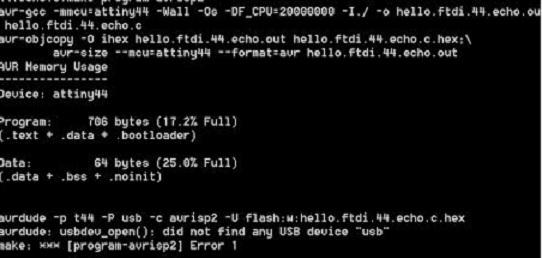Week 7: Embedded
Programming
This week, I studied a microcontroller datasheet
during our section with our TA, Nadya.
Then I spent more of my time to learn AVR
programming in Windows. Helpful resources are: high low tech
tutorials, fab academy instructions, youtube videos and 2013
archives (in particular Matt Carney if you are working on
windows).
First of all, I need to install all the software (including
drivers) to my PC. These include WinAVR, FabISP firmware, 64-bit
windows drivers for USBTinyISP and FTDI drivers. However, I tried
to follow the instructions from Mighty
Ohm, but I suspect the USB driver installation workaround
mentioned in the instructions did not work for my machine as I
continue to get Error 1 during WinAVR programming.
Indeed, installing Win AVR and different drivers were quite a
project for beginners. I referred to multiple Youtube videos to
see how other people did it in Windows.
I tried to two different ways to program my board: (1) using a
"makefile" and (2) manually compile code using windows command
window. Then, I also tried to check if hello.ftdi.44.echo is
working.
First method: using a "makefile"
1. Download all the files on course page into a folder.
2. Open windows command window in this folder.
3. Type: make -f hello.ftdi.44.echo.c.make program-avrisp2
4. This will convert the c files into hex files.

Second method: manually compile code using
windows command window
1. Compile an assembeler file: avr-gcc -mmcu=attiny44 -o
hello.ftdi.44.echo.out hello.ftdi.44.echo.c
2. Compile a hex file from assembler file: avr-objcopy -o ihex
hello.ftdi.44.echo.out hello.ftdi.44.echo.hex
3. Program the microcontroller: avrdude -p t44 -c usbtiny -U
flash:w:ftdi.44.echo.hex
The process went thru and I can see hex file created in the
folder. However it also returned Error 1 as PC doesn't seem to
recognize USB.
Check if hello.ftdi.44.echo is working
1. Open a terminal program such as Python
terminal. You should download this file to your PC.
2. However, in order to make above work, you need to install Python
2.7
and PySerial. I also
installed unofficial Windows binaries for Python Extensions.
3. Then I typed in python term.py com6 115200.
4. However, the system first returned "python is not recognized
as a syntax." I used Youtube again and realize I need to edit
the "path" in control panel -> system -> advanced setting.
I managed to make this work.
5. Then I got to terminal window for the port. Yet, as I suspect
my USB driver is not correctly installed, the terminal did not
return keystrokes as I typed...
